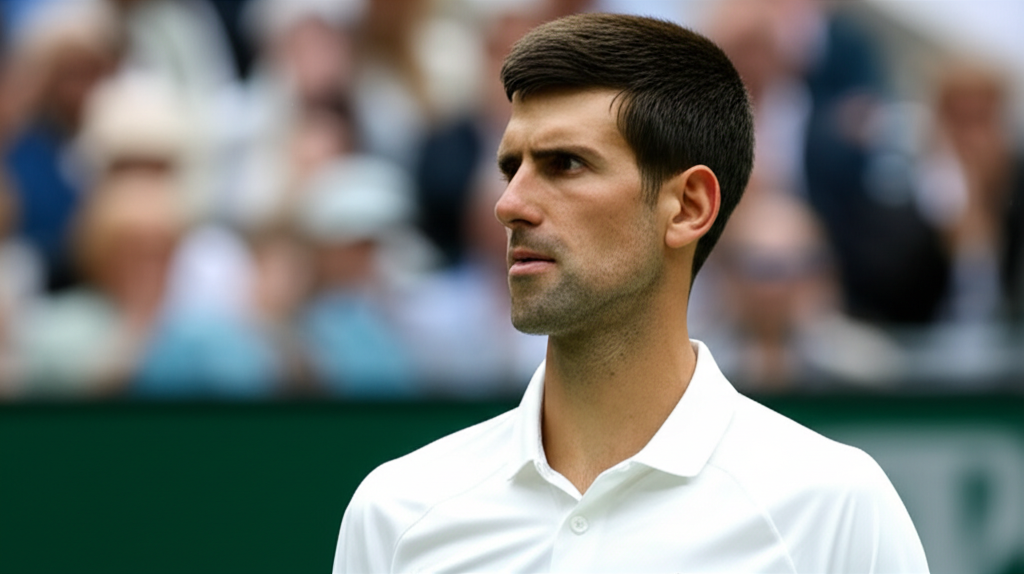Djokovic’s Call for Rivalry: A Veteran’s Perspective on Tennis’s Shifting Landscape
The Serbian legend urges the next generation to rise and meet the challenge posed by emerging stars.
Novak Djokovic, a titan of the men’s tennis world and the holder of 24 Grand Slam titles, has recently articulated a nuanced perspective on the evolving competitive dynamic at the highest echelons of the sport. As he navigates the later stages of his illustrious career, Djokovic has openly expressed a desire to see stronger challenges emerge from his fellow competitors, particularly those who might one day fill the void left by today’s leading figures.
Djokovic’s Expectations for the Next Wave
The 36-year-old Serbian, speaking in the context of events like the US Open, has indicated that he is looking for a more robust and consistent push from a broader range of players. His comments suggest a personal motivation rooted in maintaining his own high standards and a broader concern for the health and dynamism of the sport. Djokovic has specifically mentioned Carlos Alcaraz and Jannik Sinner as players who have already demonstrated their significant potential and capacity to challenge for major titles. However, his broader appeal seems directed at a wider group of aspiring professionals, encouraging them to elevate their game and provide the sustained competition that fuels greatness.
The Rise of Alcaraz and Sinner
Carlos Alcaraz, the young Spanish phenom, has rapidly ascended the rankings, capturing multiple Grand Slam titles and establishing himself as a formidable force. His electrifying style and mental fortitude have drawn comparisons to earlier eras of tennis dominance. Similarly, Jannik Sinner of Italy has shown remarkable improvement and consistency, securing significant victories and solidifying his position among the top contenders. These two players represent the vanguard of a new generation that Djokovic acknowledges as capable of leading the sport forward.
A Veteran’s View on Competitive Longevity
Djokovic’s remarks can be interpreted through the lens of a seasoned champion who understands the importance of sustained rivalry in defining legacies. For years, Djokovic, along with contemporaries like Roger Federer and Rafael Nadal, engaged in a fierce, multi-faceted competition that captivated audiences worldwide. As those rivals have either retired or are nearing the end of their careers, Djokovic appears to be seeking a similar level of intense, back-and-forth battles with a new cohort of players. This desire is not simply about winning; it’s about being pushed to one’s absolute limit by worthy adversaries, a dynamic that often brings out the best in athletes.
The Broader Implications for Tennis
The health of any sport is often measured by the depth of its talent pool and the emergence of compelling narratives. Djokovic’s call for greater challenge underscores the ongoing transition in men’s tennis. While Alcaraz and Sinner are leading the charge, the sport benefits from having multiple players consistently vying for the top spots. A diverse range of contenders ensures broader fan engagement and provides more storylines that can captivate a global audience. The absence of widespread, consistent challenges from a larger group of players could, over time, lead to a perception of predictability, which might not be ideal for the sport’s long-term appeal.
What This Means for Aspiring Players
For the many players on the ATP tour who aspire to reach Djokovic’s level, his statements serve as both an acknowledgment of their potential and a clear challenge. The message is direct: the opportunity is there, the stage is set, and the sport needs new champions to emerge and consistently test the established order. This requires not just talent, but also unwavering dedication, mental resilience, and a strategic approach to development and competition. Players who can consistently perform at the highest level, navigate pressure situations, and adapt their game will be the ones to watch.
Potential Tradeoffs and Considerations
While Djokovic’s desire for stronger competition is understandable from a sporting perspective, it also highlights the immense challenge faced by younger players. Stepping into the arena against established legends like Djokovic, even as they age, requires a significant mental and tactical adjustment. The pressure of expectation, coupled with the need to adapt to different playing styles and match situations, presents a steep learning curve. For some, the progression may be gradual, involving smaller victories and consistent improvement before major breakthroughs. The key is sustained effort and belief in their own capabilities.
Looking Ahead in Men’s Tennis
As the tennis calendar continues, all eyes will be on how the next generation responds to Djokovic’s call. The upcoming Grand Slams and Masters 1000 events will be crucial in observing which players can consistently challenge the current elite and make their mark. The narrative of tennis is always in flux, and Djokovic’s perspective offers a valuable insight into the mind of a champion contemplating the future of his sport. His legacy will undoubtedly be shaped not only by his own achievements but also by the level of competition he inspires and faces in these closing chapters of his career.
Key Takeaways:
- Novak Djokovic is encouraging a broader field of male tennis players to step up and challenge the sport’s top contenders.
- He specifically named Carlos Alcaraz and Jannik Sinner as players already meeting this expectation.
- Djokovic’s comments reflect a desire for intense rivalry, which he believes is crucial for his own motivation and the sport’s dynamism.
- The evolution of men’s tennis hinges on the emergence of new, consistent challengers to maintain broad fan engagement.
- Aspiring players are presented with an open opportunity to prove themselves against the sport’s most decorated athletes.
References
- US Open Official Website: For information on the tournament and player results.
- ATP Tour Official Website: For player rankings, tournament schedules, and official statistics.


























